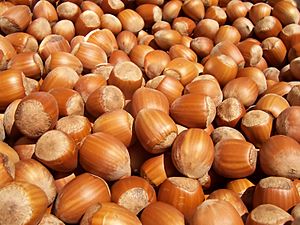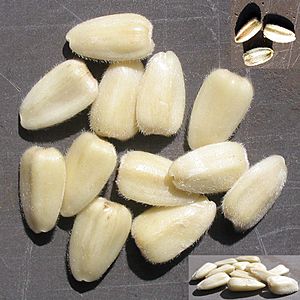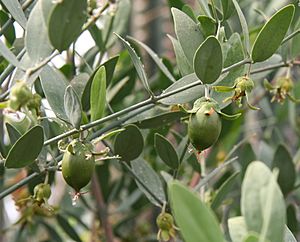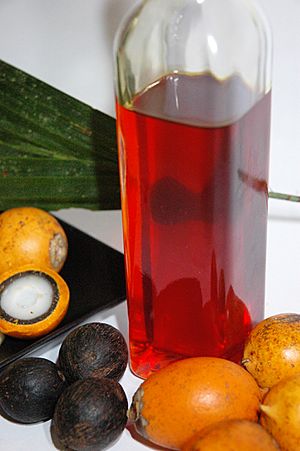List of vegetable oils facts for kids
Vegetable oils are special oils that come from plants. People have used these oils for thousands of years! You can find edible vegetable oils in your food. They are used for cooking and as extra ingredients.
Many oils, both edible and non-ededible, can be burned as fuel. Think of old oil lamps or even as a replacement for petroleum-based fuels. Beyond food and fuel, oils have many other cool uses. They can be used for wood finishing, oil painting, and even in skin care products.
Contents
What are Vegetable Oils?
The term "vegetable oil" can mean different things. Sometimes it means only oils that are liquid at room temperature. Other times, it includes oils that are solid, like coconut oil. Most oils on this list are liquid, but some are solid.
How are Oils Grouped?
Vegetable oils can be grouped in a few ways. We can group them by how they are used. We can also group them by how they are taken out of the plant. In this article, we will group them by their common uses.
How Oils are Taken Out of Plants
There are different ways to get oil from plants. These methods create different types of plant oils.
- Pressed Oils: The plant part, like a seed, is squeezed very hard. This pushes the oil out. Most oils on this list are made this way.
- Extracted Oils: Parts of the plant are mixed with water or another liquid. The oil dissolves in the liquid. Then, the oil is separated.
- Distilled Oils: The oil is heated and turned into a vapor. This vapor is then cooled to get the oil. Oils made this way are called essential oils. They often have different uses than pressed oils.
- Macerated Oils: These are made by soaking plant parts in a base oil. This process is like infusing.
Where Do Oils Come From?
Most vegetable oils come from the fruits or seeds of plants. For example, palm oil comes from palm fruits. Soybean oil comes from soybean seeds.
Some oils are grouped by the type of plant they come from. For instance, "nut oils" come from different kinds of nuts. Many plants have some oil, but only a few are widely used and traded around the world.
What are Oils Used For?
Plant oils are used for many different things.
- Cooking: Edible oils are used for cooking and as food additives.
- Fuel: Many vegetable oils can be burned as fuel. They can even replace petroleum-based fuels.
- Other Uses: Oils are also used in cosmetics, for medical reasons, wood finishing, oil painting, and other industrial purposes.
Edible Oils
These are oils you can eat! Many are used for cooking.
Main Cooking Oils
These oils are produced in large amounts worldwide. They are also sometimes used as fuel oils.
- Coconut oil: This oil is used for cooking. It also has medical and industrial uses. It comes from the inside of the coconut palm fruit. It's very common in warm, tropical places.
- Corn oil: This is a popular oil sold for salads and cooking oil.
- Cottonseed oil: Used for salads and cooking, both at home and in factories.
- Olive oil: Used in cooking, cosmetics, soaps, and for old-fashioned oil lamps.
- Palm oil: This is the most produced oil in tropical areas. It's popular in West African and Brazilian food. It's also used to make biofuel.
- Peanut oil: A clear oil used for salad dressings. It's great for frying because it can get very hot before smoking.
- Rapeseed oil: This includes Canola oil. It's one of the most sold cooking oils globally. It's used for salads and cooking. It's also used in the fuel industry as bio-fuel.
- Safflower oil: Used to be in paints. Now, it's mostly a cooking oil.
- Sesame oil: Light sesame oil is cold-pressed for cooking. Hot-pressed sesame oil has a darker color and stronger flavor.
- Soybean oil: This oil is made when processing soy meal.
- Sunflower oil: A common cooking oil. It's also used to make biodiesel.
Nut Oils
Nut oils are usually used in cooking for their special flavor. Most are quite expensive. This is because it's hard to get the oil out of nuts.
- Almond oil: Used as an edible oil. It's mostly used to make cosmetics.
- Brazil nut oil: This oil has a mild, pleasant flavor. It can be used like olive oil.
- Cashew oil: Similar to olive oil. It might help fight cavities.
- Hazelnut oil: Mainly used for its flavor. Also used in skin care.
- Macadamia oil: Has a mild nutty flavor. It can get very hot before smoking.
- Pecan oil: Valued as a food oil. It needs fresh pecans to make good quality oil.
- Pine nut oil: Sold as a fancy cooking oil. It might help you feel less hungry.
- Pistachio oil: A strong-flavored oil with a unique green color.
- Walnut oil: Used for its flavor. Renaissance painters also used it in their oil paints.
- Pumpkin seed oil
Citrus Oils
Many citrus plants give us pressed oils. Some, like lemon and orange oil, are used as essential oils. This is unusual for pressed oils. The seeds of most citrus fruits can give usable oils.
- Grapefruit seed oil: Comes from grapefruit seeds. It was found to be good for making soap.
- Lemon oil: Smells like the fruit. It's used for flavoring and in aromatherapy.
- Orange oil: Like lemon oil, it's pressed, not distilled. Used as a scent, in cleaning products, and to flavor foods.
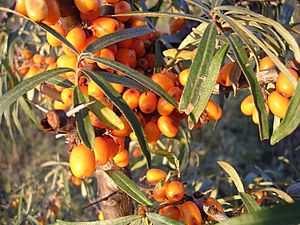
Oils from Melon and Gourd Seeds
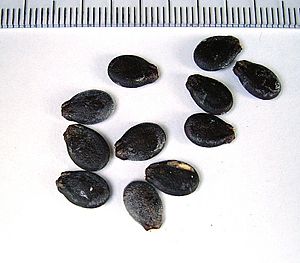
Plants like gourds, melons, pumpkins, and squashes have seeds rich in oil. These plants are mostly grown for food. The oils are a bonus from using the seeds.
- Pumpkin seed oil: A special cooking oil. It's made in places like Austria. Mostly used in salad dressings.
- Watermelon seed oil: Pressed from watermelon seeds. It's traditionally used for cooking in West Africa.
Food Supplements
Some oils are used as food supplements. People take them for their nutrients or for health benefits.
- Black seed oil: Has a long history of medicinal use. It's being studied by doctors today.
- Blackcurrant seed oil: Used as a food supplement. It's high in healthy fats.
- Borage seed oil: Comes from the seeds of the Borago officinalis plant.
- Evening primrose oil: Comes from the seeds of the Oenothera biennis plant. It's an important source of a healthy fat called gamma-Linolenic acid.
- Flaxseed oil: Comes from flax seeds. It's high in healthy omega-3 fats. It can go bad easily.
Other Edible Oils
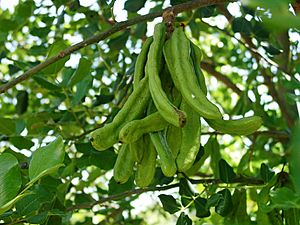
- Apricot oil: Similar to almond oil. Used in cosmetics.
- Argan oil: From the seeds of the Argania spinosa tree. It's a food oil from Morocco.
- Avocado oil: An edible oil. It's mostly used in cosmetics and medicines. It has a very high smoke point.
- Cocoa butter: From the cacao plant. Used to make chocolate and in some creams.
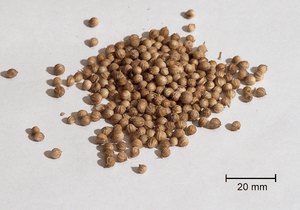
- Coriander seed oil: From coriander seeds. Used for flavoring many foods. It might help kill food bacteria.
- Grape seed oil: A cooking and salad oil. Also sprayed on raisins to keep their flavor.
- Hemp oil: A high-quality food oil. Also used to make paints and soaps.
- Mustard oil (pressed): Used in India as a cooking oil. Also used for massage.
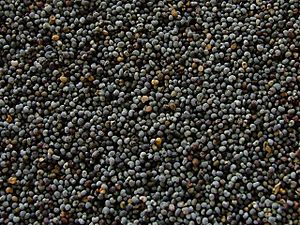
- Poppyseed oil: Used for cooking for a long time. Also used in paints and soaps.
- Rice bran oil: A very stable cooking and salad oil. Good for high-temperature cooking. It could also be a biofuel.
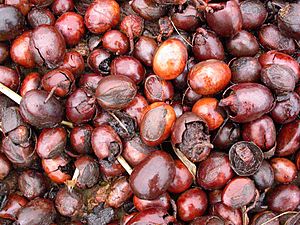
- Shea butter: Mostly made by women in Africa. Used in skin care products. Also used in sweets and cosmetics.
- Tea seed oil: Widely used in southern China as a cooking oil. Also used in soaps and hair oils.
- Wheat germ oil: Used for nutrition and in cosmetics. It's high in vitamin E.
Oils Used for Biofuel
Some oils are used as biofuel. This means they can power engines, like biodiesel. They can also be used as Straight Vegetable Oil.
Even though diesel engines were partly designed for vegetable oil, most diesel fuel today comes from petroleum. Vegetable oils are checked to see if they are good for biofuel. They look at things like:
- How well it burns.
- How much energy it has.
- How thick it is.
- Its cost.
Oils Used for Many Things and Biofuel
The oils below are mainly used for other purposes. Most of them are edible. But they can also be used as biofuel.
- Castor oil: Cheaper than many other options.
- Coconut oil: Good for local use in places where coconuts grow.
- Corn oil: Appealing because corn is a very common crop.
- Cottonseed oil: Studied to see if it's cost-effective as a biodiesel source.
- Hemp oil: Produces less pollution.
- Mustard oil: Similar to Canola oil as a biofuel.
- Palm oil: Very popular for biofuel. But growing large amounts of palm trees can harm the environment.
- Peanut oil: Used in one of the first demonstrations of the Diesel engine in 1900.
- Rapeseed oil: The most common oil used for biodiesel in Europe.
- Rice bran oil: Cheaper than many other vegetable oils. Widely grown in Asia.
- Safflower oil: Recently explored as a biofuel.
- Soybean oil: Not cheap to grow just for fuel. But it's good as a byproduct from growing soybeans for other uses.
- Sunflower oil: Good as a fuel, but not always cheap enough.
- Tung oil: Used in several lists of oils suitable for biodiesel.
Oils Used Only or Mostly as Biofuel
These oils come from plants grown just to make oil-based biofuel.
- Jatropha oil: Widely used in India as a fuel oil. Many people support its use as a biofuel.
- Jojoba oil: From the Simmondsia chinensis, a desert plant.
- Pongamia oil: Also known as Honge oil. It was first used as a biofuel in Bangalore, India.
Drying Oils
Drying oils are vegetable oils that become hard when they dry at room temperature. These oils are used to make oil paints. They are also used for other paints and for finishing wood. Besides the oils listed here, walnut, sunflower, and safflower oil are also drying oils.
- Linseed oil: Very good for finishing wood. Also used in oil paints and in making linoleum. When used in food, it's called flaxseed oil.
- Poppyseed oil: Used like linseed oil. It keeps its color better.
- Tung oil: Used as an industrial lubricant. It's a very good drying agent. Also used instead of linseed oil.
Other Oils
Some pressed vegetable oils are not edible. Or they are not used as food oils.
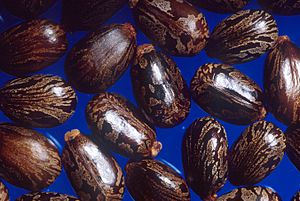
- Artichoke oil: From artichoke seeds. It can be used to make soap, shampoo, and shoe polish.
- Burdock oil: From the root of the burdock plant. Used as a natural remedy for scalp problems.
- Buriti oil: From the Mauritia flexuosa fruit. High in healthy nutrients. Also used in cosmetics.
- Candlenut oil: Made in Hawai'i. Mostly used for skin care products.
- Castor oil: Has many industrial and medical uses. Castor beans also contain a toxin called ricin.
- Jojoba oil: Used in cosmetics as a replacement for whale oil.
- Mango oil: Pressed from mango pits. High in stearic acid. Can be used for making soap.
- Neem oil: From Azadirachta indica. A brownish-green oil used in cosmetics, for medicine, and as an insecticide.
- Rose hip seed oil: Mostly used in skin care products. Especially good for aging or damaged skin.
- Sea buckthorn oil: From Hippophae rhamnoides. Produced in northern China. Mainly used for medicine.
- Tamanu oil: Important in Polynesian culture. It's expensive but used for skin care.
See also
 In Spanish: Anexo:Aceites vegetales para niños
In Spanish: Anexo:Aceites vegetales para niños
- Carrier oil discusses how vegetable oils are used with essential oils.
- Fatty acid discusses what makes up most vegetable fats and oils.
- International Nomenclature of Cosmetic Ingredients explains how oils are named in cosmetics and soaps.
- List of essential oils


